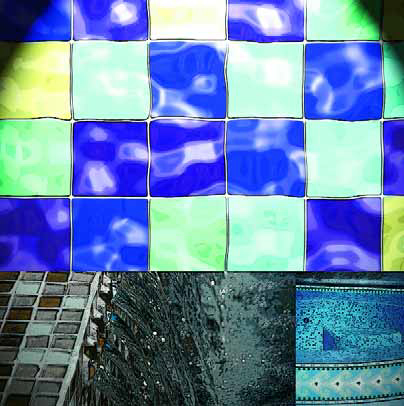ceramic
Vita Nova Luxury Mosaic (Pacoima, CA) has published a digital catalog on the 20-year-old firm’s…
For the last few months, the Getty Villa in Malibu, Calif., has hosted a special exhibit called "Stories in Stone," which is all about the nature, preservation and conservation of stone mosaics found in the ancient Roman cities of North Africa. Even a quick walk through the halls is enough to show why these art objects speak to us across the millennia: Their colors are vivid, their decorative capacity is amazing, their durability is unrivalled and their sheer beauty is a delight even to the unschooled eye. At best, tile mosaics of any caliber are both aesthetic and functional, timeless and contemporary, subtle and dramatic. They are also versatile - interior or exterior, commercial or residential - and have long been among the very best media available to designers and architects looking to infuse their work with the
For the last few months, the Getty Villa in Malibu, Calif., has hosted a special exhibit called "Stories in Stone," which is all about the nature, preservation and conservation of stone mosaics found in the ancient Roman cities of North Africa. Even a quick walk through the halls is enough to show why these art objects speak to us across the millennia: Their colors are vivid, their decorative capacity is amazing, their durability is unrivalled and their sheer beauty is a delight even to the unschooled eye. At best, tile mosaics of any caliber are both aesthetic and functional, timeless and contemporary, subtle and dramatic. They are also versatile - interior or exterior, commercial or residential - and have long been among the very best media available to designers and architects looking to infuse their work with the
My last two "Details" should make it pretty clear that I'm more enthusiastic about tile than I am about any other surface material for watershapes. In October, we covered the use of color while focusing on tile, and in November there was a discussion of my favorite suppliers and their distinctions. This time, I'll bring the sequence to a conclusion by looking at the process of selecting tile and at the ways I blend tile mosaics. My enthusiasm extends from the fact that tile in watershapes is incredibly dynamic - so visually flexible, so durable and, if done well, so elegant. It can be used either as a
I know I've quoted or paraphrased Ernest Hemingway on this point before, but it bears repeating once again: Anything that was ever any good, you pay for. I'd go so far to say I've based my entire business philosophy on that basic idea. For one thing, there's an essential truth to what he's saying. For another, I see its clear application to watershaping on a variety of levels - particularly when it comes to the materials we use in creating our "art." Indeed, a huge part of giving clients the unique elegance and beauty they so often crave involves understanding and appreciating
Value is measured and determined in a variety of ways. When it comes to pools and spas, for example, I'd say that the straight-dollar value is only one of several yardsticks and that, for many clients, it's no longer the one that tops their lists. Instead, beauty, health benefits, artistic merit, pride of ownership and emotional appeal are more important than price tag for many of them - a wonderful trend, to my way of thinking. These measures of value, of course, are highly subjective. Every client is a little bit different, and the relative value of non-monetary factors can be
When I was a kid in Caltagirone, Sicily, everybody worked hard all the time - grueling manual labor in the fields and factories. By the time I was eight years old, I was already working with my father in a ceramic-sculpture foundry. I didn't do much more than sweep the floors, but I was around all sorts of craftspeople and began to see that there were some forms of hard work that were more fulfilling than others. So I began to think about becoming a painter. I took my first steps in that direction at 13. By the time I was 18, I'd opened a studio and was painting and sculpting on my own. In those days, the arts community was an exciting place where we shared ideas, fed on each others' energy and competed with each other for good commissions. I'm not ashamed to admit that I thought the established artists I hung out with were cool and powerful in their own ways - and that I wanted to be just like them. Given the specific nature of my art, it's not surprising that the great Italian masters heavily influenced my work right from the start, including Michelangelo, Raphael and especially Leonardo Da Vinci. They are my heroes, and I see the work I do as a modest continuation of the traditions they established. These artists taught me that great art is about passion and the desire to



















